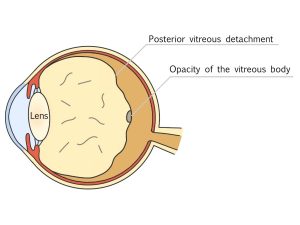The vitreous body in the eye degenerates and liquifies as patients get older. There is also shrinking and condensation of the vitreous. This results in dark specks in the vitreous seen by the patient as floaters.
Occasionally floaters occur congenitally or by other eye disease.

(When the vitreous body becomes opaque, symptoms of floaters appear.)
Present from birth
In some cases, floaters can be congenital (present at birth). This is because the blood vessels pass through the vitreous until the baby’s eyeball is formed in the mother’s womb. If blood vessels remain in the vitreous after birth, they eventually become cloudy and appear as floaters.
However, as long as the symptoms don’t get worse, there is no need to be concerned.
In case of disease
After birth, the development of floaters can be caused by bleeding around the vitreous or by inflammatory cells entering the vitreous.
Vitreous hemorrhage and inflammatory diseases such as uveitis are the most common causes, but it can also be caused by hereditary vitreous diseases and systemic diseases. Most people who suffer from retinal detachment experience floaters in the early stages of the disease. Diabetic retinopathy, in which the retinal vessels are damaged due to diabetes mellitus, should also be considered.
In case of aging
The healthy vitreous is consisted of a clear viscous, liquid similar to the white of an egg. However, as we age, a small chamber-like cavity filled with fluid is formed inside the vitreous. As the space gets larger and larger, the vitreous body shrinks.
These changes in the vitreous body can cause cloudiness which can lead to floaters. When the back wall of the cavity ruptures, fluid flows out, leaving a contracted vitreous body at the anterior portion of the eye and fluid at the posterior portion of the eye. The vitreous, which is normally attached to the retina, detached from retina, causing sudden appearance of floaters.
Even if floaters appear, it‘s difficult to determine by yourself whether the cause is due to the disease. Therefore, if you’re concerned about the symptoms of floaters or if they suddenly become severe, please see an ophthalmologist.



